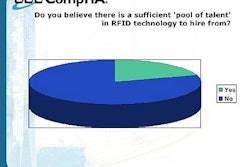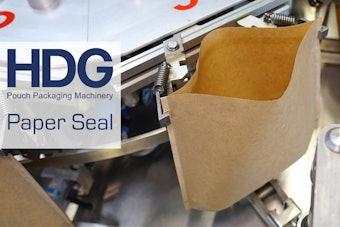
Is packaging a means to an end or is it something that presents a strategic advantage for the goods maker? Too often the answer is the former and that needs to be rethought, especially now that a new standard is emerging in RFID.
But how will an RFID standard create strategic advantage? By itself it won’t. If you believe RFID is just another slap-and-ship requirement from your customer then you’ll see Gen 2 as a way to make their supply chains more efficient, but at a cost to you that you may not be able to pass along to them. If you look more broadly, you’ll see that Gen 2 represents opportunities for your packaging and your customer.
But that’s only if you are creative. For CPG companies, the acceptance of the Gen 2 standards is an incomplete step. The Gen 2 standard for RFID addresses the hardware details between the tags and the readers. It deals with frequencies, strength of signal, and the basic shape of the messages flowing between the tags and the readers/writers (also called interrogators). It is akin to the standards for a one or two-dimensional bar codes in that it defines the details of how a scanner reads the code or tag without detailing the meaning of the content of what is being read. CPG companies assume that the RFID hardware industry is going to develop and sell products that will communicate with each other effectively regardless of geography or manufacturer. They see the acceptance of the Gen 2 standard as a guarantee of assurance that the industry will make this expectation real.
Standard expectations
What is missing is the definition of the content’s format and meaning. This is more in EPC global’s court, as well as other standards bodies. We should expect RFID standards development and roll-out to pursue a track very similar to Electronic Data Interchange (EDI) and EDI-FACT (the European/United Nations equivalent). Broad standards will be developed and industry organizations may modify these broad standards to accommodate their industry’s special needs. In the case of supplying product to Wal-Mart or the Department of Defense, the published EPC Global standards are proving dominant. This is all a good thing, yet still evolving.
The key to more rapid implementation of RFID by more CPG manufacturers is a solution that allows them to implement RFID without eroding their margins into oblivion. Slap and ship operations do nothing but give compliance through more complex operational procedures and as an added cost. The solution lies in the application of tags at a point in the manufacturing process that is more convenient and farther upstream.
If the packaging is designed and manufactured with programmable RFID tags that meet the Gen 2 standard (or earlier standards for Class 0 and 1 tags), then the added cost for applying and programming the compliant tags late in the manufacturing process is mitigated.
The majority of packaging manufacturers sell a commodity product and look at pricing and cost control as the means to their margins. Those companies that look at innovation as a way to insure market share and raise the added value of what they sell are the leaders in any industry.
Add value through RFID
Packaging is no exception. RFID is the latest way to insert innovation into a commodity business. Other companies are looking at embedding a high-frequency RFID tag in the caps of pill bottles as an innovative combination of RFID and packaging design for the pharmaceutical industry.
The key for CPG companies is to work innovatively with their packaging suppliers to combine RFID and packaging design to mitigate the costs of RFID compliance and usage.
How to mitigate the costs of RFID?
In order to mitigate the immediate costs associated with RFID compliance, enterprises need to find ways to reduce the high cost and added complexity of "last minute" "slap and ship" application of RFID compliant labels. For instance:
Develop tactics for RF physics, too
CPG companies should interact with customers to determine tag placement and design, help resolve the issues imposed by RF physics and understand the affects of product content (liquid, density) and packaging (metal cans, foil wrapping). They should include their packaging suppliers in this process and accelerate the development of an integrated packaging product that insures effective RFID tag operation.
Innovative CPG companies will form new alliances with packaging and graphics design firms to create solutions that meet the requirements of their customers while offering themselves an integrated RFID Gen 2 compliant solution that meets their needs to be cost effective. This primarily applies to item level packaging, but some innovative retailers are also very interested in attractive case level package design (e.g. Sam’s Club). To do this, CPG companies need to launch a 90-day plan to execute the following:
1. Identify a set of target clients from your existing installed base that have burgeoning RFID requirements (e.g. Wal-Mart, Target, Metro), DOD specifications, or FDA specifications.
2. Identify and ally with a key packaging supplier and a graphics and package design firm.
3. Investigate and learn what the customer’s specific requirements are and how these requirements adversely affect your margins. Discover where in the manufacturing process you can eliminate the “cast of Ben-Hur” you currently use to be compliant to your customer’s RFID mandates.
4. Develop a prototype packaging solution to meet these requirements while mitigating your margin erosion from slap and ship operations.
5. Test the prototype solutions within your manufacturing operations and with your customers. Modify as appropriate, and then roll out (the roll out is an addition to the 90 day plan).
The CPG company that proactively builds an integrated packaging and RFID solution will differentiate itself by offering RFID compliant products that are cost effective to produce.
Thomas Ryan is an information technology and logistics professional with more than 25 years of experience in warehouse and transportation operations and systems, enterprise integration technology architecture, and supply chain collaboration enablement through the application of technology. He is currently Principal, TKR Consulting Associates.






















